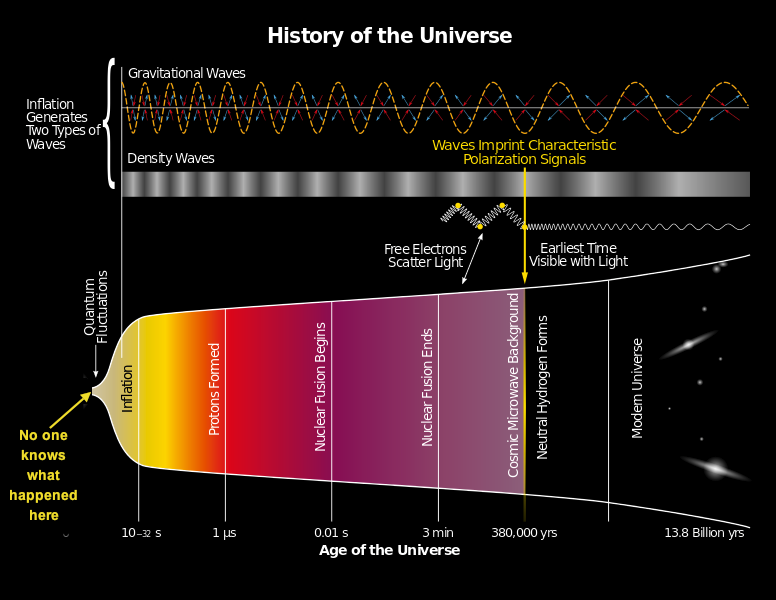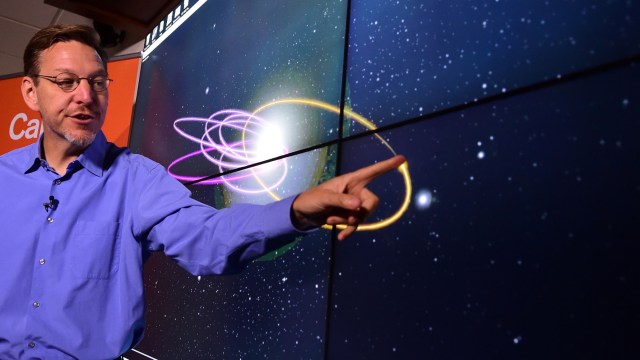Gravitational Waves Give Us A New Way To Look At The Universe

It’s not in any form of light, and yet here we are, “seeing” the Universe all the same.
“If the imprint is really due to gravitational waves from the big bang, then this is the type of cosmological discovery that comes along perhaps once every fifty years.” –Kip Thorne
Imagine that instead of the Sun, Moon, planets and stars in the sky, all you had ever seen was clouds. Not the puffy white ones silhouetted against a blue sky, but the thick gray, expansive stratus clouds that are the hallmarks of a dreary winter. But unlike the winter clouds that last for weeks or months at worst, these lasted for all of human history. Yet someone devised the means to part the clouds one night, just for a short while, and allowed us to glimpse the Universe beyond our atmosphere, ever so briefly. Imagine that there was just one point of light that shone through, perhaps a planet, with incredible detail on it: rings, bands, colors, and maybe even moons. How dramatically would your conception of the Universe change from that moment? Now that the results are in — the LIGO collaboration has indeed detected gravitational waves from two merging black holes — we can recognize that we’ve just had exactly that type of moment in astronomy.

For the first time, one of the oldest unconfirmed predictions of Einstein’s greatest accomplishment, the general theory of relativity, has been successfully put to the test. Two black holes in a far-off galaxy, some 1.3 billion light years away, orbited one another in a cosmic death-spiral, radiating their gravitational energy away until they at last merged, releasing three solar masses worth of material into ripples in the fabric of space itself, via E = mc^2, in the form of gravitational waves. These waves travel outwards through the Universe, causing everything they pass through to compress and expand like a racquetball being squished in one direction, then the perpendicular direction, and so on, traveling forever and ever at the speed of light.
The thing is, experiments like LIGO aren’t the only types of gravitational wave detectors we can build, merging black holes aren’t the only things we can detect, and more generally, astronomical objects aren’t the only things we can use gravitational radiation to learn about! The reason we saw inspiraling black holes first is because LIGO, the cheapest gravitational wave detector we can build that’s capable of seeing these waves as the Universe produces them, is sensitive to those types of waves. But in reality, there are all sorts of things to look for, which fall into four different classes.

1.) Compact, super-fast-moving objects. This is the class that includes what LIGO saw, where small (less than 1,000 solar mass) black holes merge together. Merging neutron stars will also produce gravitational waves, as will individual pulsars, and as will supernovae of both main varieties. LIGO will see the more massive, equal mass black holes first, and is expected to see a handful of them per year. Remember, the detector only came online in September of 2015, and the announced signal came from September 14, 2015. There’s likely to be many more black hole mergers in the coming few years, particularly as LIGO’s sensitivity improves and its search range gets extended farther and farther into the deep Universe. The big thing that determines which objects fall into this range is their frequency, or how many times-per-second these objects emit a wave. LIGO can detect objects from about 1-to-10,000 Hz, which means objects that emit waves more than once per second!

2.) Slower and/or more massive objects. These won’t have fields that are quite as strong as the objects LIGO sees, but there are many more objects like this out there in the Universe for us to examine. At the heart of nearly every galaxy — including our own — is a supermassive black hole, with millions or more times the mass of the Sun inside. A detector whose arms are far larger than Earth, like a giant space antenna in the form of LISA (or eLISA), can locate these. Binary stars, binary white dwarfs, supermassive black holes eating other objects, and highly unequal-mass mergers will all emit gravitational waves of much lower frequencies, where they take minutes, hours or even days to emit gravitational waves. We can’t see them with LIGO, but a much larger interferometer in space would be sensitive to them. IfNASA decides to invest in it (and even if it doesn’t, ESA will), we can fly our first detectors for these objects sometime in the 2030s.

3.) Ultra-massive black hole orbits and mergers. Ever heard of a quasar, or of an active galactic nucleus? These billion-solar-mass black holes at the cores of active galaxies had to get that big somehow, and it most likely came from gigantic mergers. There’s even one such system, OJ 287, where a 100 million solar mass black hole orbits an 18 billion solar mass black hole, that it’s known must emit a tremendous amount of gravitational waves. These have orbital periods on the order of years, and the corresponding incredibly low frequencies to go along with it. Using conventional laser-based detectors is impractical for this, but using an array of pulsars — and seeing how their timing is affected — would do the trick. This is something the NANOgrav collaboration, just starting out, will be working to make happen over the coming decades.

4.) Relic gravitational wave radiation from the Big Bang. And why stop with astrophysical sources? These fluctuations from the birth of the Universe would show up in the polarization of the leftover light from the Big Bang, and are being looked for right now! You’ll remember that BICEP2 erroneously announced the discovery of these waves back in 2014, only to discover that the foreground dust from our own galaxy accounted for that polarization signal. But these gravitational waves should exist, and they should exist at all frequencies. Depending on what we find — what the amplitude and spectrum of these waves are — we can potentially reconstruct exactly what the earliest moments of our Universe, and what the end of inflation, was really like.

In addition, it isn’t just that gravitational waves come from these sources, it’s that each one of these sources can potentially teach us a tremendous amount about the Universe. Yes, there’s astrophysics involved, but the more sensitively we can measure each of these things, the more we can learn about:
- the types of gravitational waves emitted by each of these classes of sources,
- the physics of the critical, final moments of mergers, supernovae, and other cataclysmic events as viewed through gravitational waves,
- and with the potential, at high enough sensitivities, to look for quantum gravitational effects that may depart from general relativity.
There are proposed future observational missions looking to observe a great many of these at sensitivities outclassing all of the missions enumerated above, like NASA’s Big Bang Observer, which would probe all the sources in classes 1, 2 and 4 to better accuracy than any other proposed mission. An array of six interferometers near Earth in orbit, with three at each of the L4 and L5 Lagrange points, could improve our sensitivities over LISA and LIGO by many orders of magnitude, allowing us to measure the leftover gravitational waves from inflation directly.

In addition, the possibility of correlating optical astronomy with gravitational wave astronomy can give us multiple views of the same objects, teaching us more about the Universe than we’d ever known. You might have wondered if two merging black holes would emit some sort of electromagnetic radiation, like gamma rays?
Well, even though we’ve only got one event in gravitational radiation, there was a very suspicious coincidence of a gamma-ray burst detected by NASA’s Fermi satellite just 0.4 seconds (!) after the LIGO signal. When we have three or four gravitational wave detectors up and running (VIRGO and CLIO in addition to the two LIGO detectors), we can better constrain the position of these sources, and perhaps find out once and for all what kinds of electromagnetic radiation these black hole mergers produce.

We’re right on the frontiers of opening up the Universe in a brand new way. The event of September 14th detected by LIGO was only the first of what’s sure to be a massive influx of new data that will teach us about the Universe in a form of energy we’ve never directly probed before. It’s time to embrace this new form of astronomy, and to open our window on the Universe as never before. It’s an incredible time for any curious minds to be alive.
This post first appeared at Forbes. Leave your comments on our forum, check out our first book: Beyond The Galaxy, and support our Patreon campaign!





